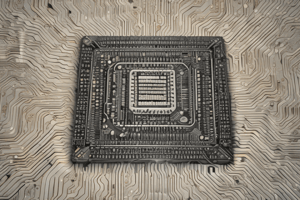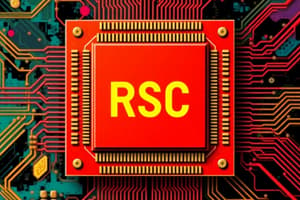Podcast
Questions and Answers
Describe the role of the ALU control in the simple implementation scheme of the datapath.
Describe the role of the ALU control in the simple implementation scheme of the datapath.
The ALU control determines the operation that the ALU should perform based on the instruction provided.
What are the functions of the MemRead and MemWrite signals in this datapath implementation?
What are the functions of the MemRead and MemWrite signals in this datapath implementation?
MemRead signals the datapath to read data from memory, while MemWrite signals to write data into memory.
Explain the significance of the RegWrite signal in the context of the datapath.
Explain the significance of the RegWrite signal in the context of the datapath.
The RegWrite signal enables the writing of data back into the registers from the ALU or memory.
What does the MemtoReg control signal accomplish in this implementation scheme?
What does the MemtoReg control signal accomplish in this implementation scheme?
How is the immediate value generated and utilized within the datapath?
How is the immediate value generated and utilized within the datapath?
What operation does the ALU perform when the ALUOp control is set to '00'?
What operation does the ALU perform when the ALUOp control is set to '00'?
How does the ALU determine if the result of a subtraction operation is zero?
How does the ALU determine if the result of a subtraction operation is zero?
What are the funct7 and funct3 fields used for in the ALU control scheme?
What are the funct7 and funct3 fields used for in the ALU control scheme?
Why is it beneficial to use multiple levels of control in the ALU's design?
Why is it beneficial to use multiple levels of control in the ALU's design?
What do the 'X's signify in the encoding of ALUOp bits when they are set to '00' or '01'?
What do the 'X's signify in the encoding of ALUOp bits when they are set to '00' or '01'?
What are don’t-care terms in the context of truth tables for ALU design?
What are don’t-care terms in the context of truth tables for ALU design?
Explain the significance of the funct field in R-type instructions.
Explain the significance of the funct field in R-type instructions.
Describe the relationship between ALUOp and the ALU control bits.
Describe the relationship between ALUOp and the ALU control bits.
What are the main instruction classes mentioned, and what do they signify?
What are the main instruction classes mentioned, and what do they signify?
In the context of the instruction format, what role does the immediate field fulfill in I-type load instructions?
In the context of the instruction format, what role does the immediate field fulfill in I-type load instructions?
Flashcards
Conditional branch (beq)
Conditional branch (beq)
A processor instruction that conditionally branches to a different instruction depending on whether two operands are equal.
ALUOp control bits
ALUOp control bits
A 2-bit field used to specify the operation to be performed by the Arithmetic Logic Unit (ALU).
ALU control unit
ALU control unit
A control unit that creates the 4-bit signal that directs the ALU's operation.
Funct7 and Funct3 fields
Funct7 and Funct3 fields
Signup and view all the flashcards
Multiple levels of decoding
Multiple levels of decoding
Signup and view all the flashcards
Don't-care terms in truth tables
Don't-care terms in truth tables
Signup and view all the flashcards
Instruction formats
Instruction formats
Signup and view all the flashcards
R-type instructions
R-type instructions
Signup and view all the flashcards
I-type load instruction
I-type load instruction
Signup and view all the flashcards
Datapath
Datapath
Signup and view all the flashcards
Control Unit
Control Unit
Signup and view all the flashcards
Instruction Fetch
Instruction Fetch
Signup and view all the flashcards
Registers
Registers
Signup and view all the flashcards
ALU
ALU
Signup and view all the flashcards
Study Notes
Simple Implementation Scheme
- ALU control unit takes inputs and generates signals for each state element, multiplexor selectors, and ALU control.
- Immediate generation logic selects among sign-extension options (load, store, branch), based on opcode bits.
- RISC-V ALU control inputs define four combinations (AND, OR, add, subtract).
- ALU performs various operations based on instruction type:
- Load/store instructions use addition for addressing
- R-type instructions use AND, OR, add, or subtract (depending on funct7/funct3)
- Branch-if-equal subtracts and tests for zero.
ALU Control
- RISC-V ALU has four combinations of control inputs for different operations.
- The ALU performs specific operations based on the input instruction type (load, branch, R-type).
Studying That Suits You
Use AI to generate personalized quizzes and flashcards to suit your learning preferences.




